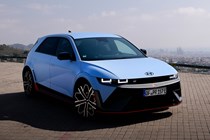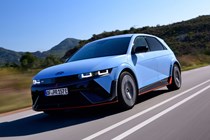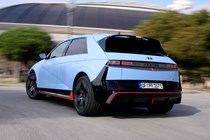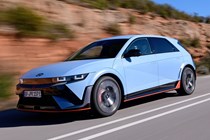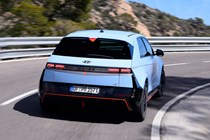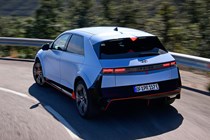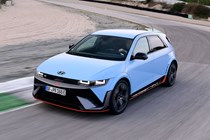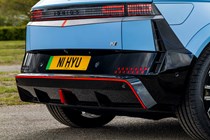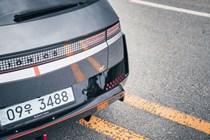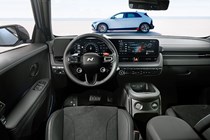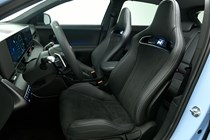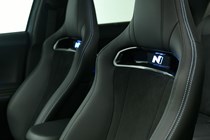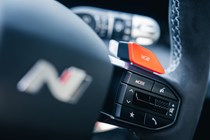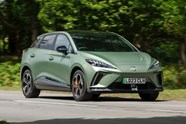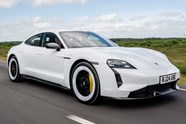
Hyundai Ioniq 5 N review

At a glance
| Price new | £65,100 - £66,350 |
|---|---|
| Used prices | £42,500 - £56,320 |
| Road tax cost | £195 - £620 |
| Insurance group | 49 |
Get an insurance quote with

|
|
| Fuel economy | 2.9 miles/kWh |
| Range | 278 miles |
| Miles per pound | 4.6 - 8.5 |
| Number of doors | 5 |
| View full specs for a specific version | |
Available fuel types
Fully electric
Pros & cons
- Staggering performance
- Entertaining to drive
- Clever technology
- It weighs 2.2 tonnes
- And it’s enormous for a hatch
- Petrol rivals are cheaper
Hyundai Ioniq 5 N rivals
Overview
Hyundai’s N division is dealing with an identity crisis. Since 2017, it’s churned out petrol-powered performance cars that have toppled the biggest brands in the business. The i30 N came first, followed by the i20 N, but now it’s hoping to do the same thing in the electric car market.
It pulled both these giant-slaying hot hatchbacks from its showrooms in February 2024 and has replaced them with this – the pure-electric Ioniq 5 N. But, if you’re a car enthusiast, fret not. We reckon it’s the only EV on sale that devout petrolheads will welcome into their inner sanctum.
Why? Well, the Ioniq 5 N pays sympathetic tribute to its petrol-powered forebears – and there’s just enough old-world charm left in its circuitry to make it feel warm and familiar. Hyundai did this by giving it synthetic engine noise and a simulated double-clutch gearbox, both of which are convincing enough to make even our most devout petrolhead staffers forget they were driving an electric car. It’s enormous fun, but can be turned off if you’d rather the usual quiet and smoothEV driving experience.
Like any other electric performance car, it’s also enormously quick. You get two electric motors (one on each axle), delivering a maximum output of 650hp and 770Nm of torque. That’s enough to shove the Ioniq 5 N from 0–62mph in just 3.4 seconds, making it more than a second over the sprint than the Volkswagen Golf R.
Scroll down to find out why we’ve been bowled over by the Hyundai Ioniq 5 N – and why you should consider buying one if you’re a petrolhead. Our review will explore its practicality, technology, driving experience, comfort and running costs before we offer our final verdict.
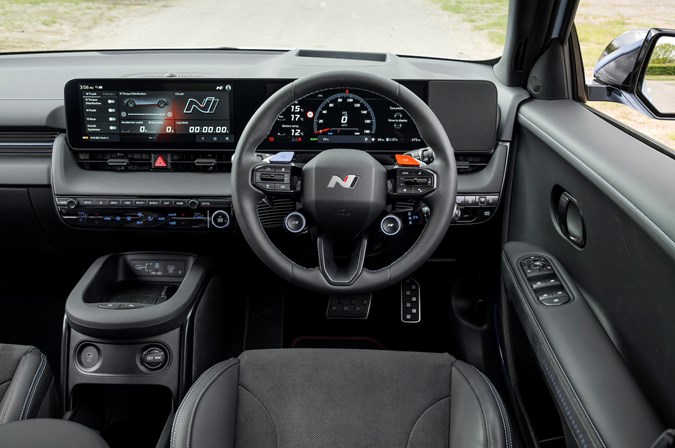
What’s it like inside?
A lot like the standard Hyundai Ioniq 5, which isn’t such a bad thing. You get the same pair of 12.3-inch screens, the same vast quantity of passenger space and the same level of build quality, which is still good enough to rival Audi and Mercedes.
The changes Hyundai has made were carefully selected to match the N’s performance. So, you get a pair of sports seats mounted 20mm closer to the car’s floor, a sports steering wheel that’s riddled with buttons for the car’s various drive modes and a fresh centre console with padded knee supports that give you something to brace yourself against when you’re cornering quickly. Some of the materials used do feel a bit on the cheaper end of the spectrum, however, but those buying a 5 N won’t be doing so for its plush interior.
It’s a very focused setup – and it’s encouraging to see how tightly Hyundai wants to embrace the enthusiast market as it moves away from petrol performance cars. That gesture is particularly noticeable in the firm’s attention to detail.
For example, the instrument cluster has dedicated temperature dials for the electric motors and battery pack. This information is pretty useless for your average EV owner, especially when you consider that, even during an intense session on a racetrack, none of the components in our test car crested 50 degrees. That’s well within the boundaries of Hyundai’s safety margins.
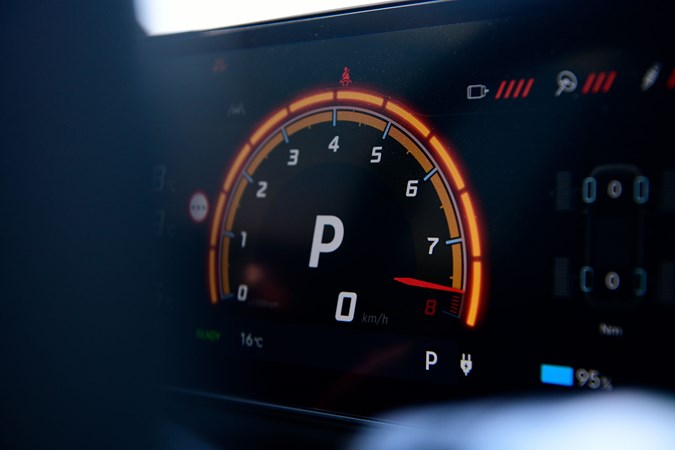
From a practical perspective, then, this lack of danger defeats the point of having the gauges to monitor the jeopardy. But we love that Hyundai decided to add them for the simple purpose of charming every car enthusiast’s secret nerdy streak.
It’s every bit as useful and practical as the standard Ioniq 5. This is a deceptively big car that looks like a normal hatchback in photos, but in person is a similar length and width to mid-to-large SUVs. But this space is all but to good use. There’s a flat floor in the rear that adds to the feeling of roominess, and the width means three adults can sit quite comfortably in the rear seats. The 527-litre boot is an excellent size too.
Comfort
We’ve driven the Ioniq 5 N several times abroad, and were hugely impressed. But the UK’s roads are notoriously poor and can sometimes show up a vehicle that has excelled on the first test drive overseas. But the 5 N excels on British tarmac.
Not surprisingly, the suspension is on the firm side, but it’s far from being uncomfortable. The ‘sport’ and ‘race’ tuned suspension setups are a bit harsh, however, so the standard setup is the way to go. Tyre roar is more noticeable but it comes on large 21-inch alloy wheels, so this is to be expected.
The seats, despite being thinner than the standard car’s, still offered enough vertical support to keep occupants comfy on the motorway. They also offer ample lateral support to hold you in place during hard cornering. If we had to criticise them, we’d have liked some lumbar adjustment.
Safety
The Hyundai Ioniq 5 N shares the same five-star Euro NCAP score as the standard car. However, it’s worth mentioning that, while the Ioniq 5’s adult and child protection scores of 88% and 86% respectively are good, rivals such as the BYD Seal and Smart #3 can do better. Still, at least you get front, centre and side airbags, a head airbag for those in the rear and two Isofix points on the outer rear seats.
What’s it like to drive?
Fabulous. The Ioniq 5 N is easily the most entertaining electric car we’ve driven yet, which is high praise in the company of the Porsche Taycan. This sparkling experience didn’t come easy, though. To achieve the effect, Hyundai’s engineers spent months combing through the Ioniq 5’s chassis and throwing a catalogue of parts at it.
Are you sitting comfortably? Because the changes are, shall we say, extensive. For starters, the N’s body shell is stitched together with an extra 42 welds and an additional 2.1 metres of structural adhesive. That allows it to cope with track-pace G forces without rattling itself into a quivering pile of bolts and panels.
Hyundai’s N division also fitted new dampers, sturdier front and rear subframes, stiffer battery and motor mounts, bigger brakes and a completely different steering rack with a faster ratio. To allow you to make the most of this new hardware, there’s also a plethora of N-branded driver assistance tech that can do everything from vector the torque of the electric motors across the axles to help you perform massive skids.
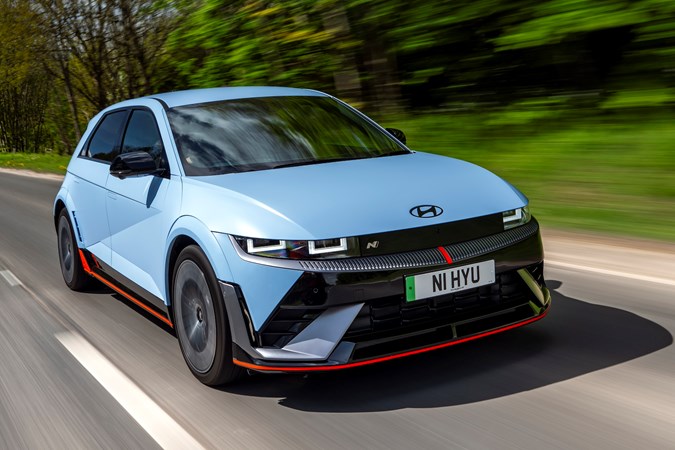
The combined effect of Hyundai’s chassis tuning and electrical wizardry is stunning. It’s noticeably more agile than the standard car, there’s far less body roll and you get way more grip, thanks in no small part to the 10-and-a-bit-inch wide Pirelli P Zero tyres. The steering also provides a lot more feedback, which means you can really place your trust in the suspension and exploit the performance.
We tried the Ioniq 5 N at Circuit Parcmotor Castelloli in Spain and can confidently report that it’s a true driver’s car. Hyundai even managed to dial a surprising amount of playfulness into the setup. That means you can feel the car moving around underneath your backside as it passes over dips and crests in the track.
If you’re really brave and tackle a corner like a fighter pilot dodging gunfire, the rear end will shimmy and shake like a rear-wheel drive car that’s fighting for grip – and you’ll have to counter-steer to keep the car pointing the right way. It’s brilliantly engaging.
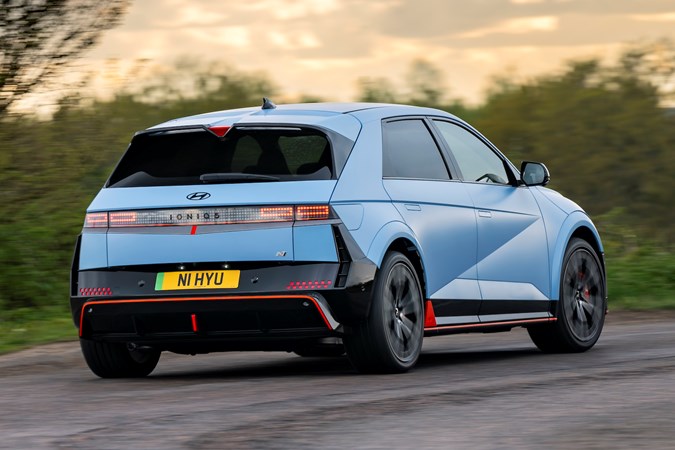
But even though your experience at the wheel feels dramatic, you’re never in any real danger. There’s an electronic safety blanket lurking beneath the N’s bravado. Push beyond the limits of your capability and the car will recognise your shortcomings. It’ll subtly snatch at the brakes and shift the power around to stop you from rattling along the Armco. It’s like the old Nissan GT-R in how elegantly it flatters you as a driver.
It’s also remarkable how quickly Hyundai’s fake engine noise and phony gear shifts tricked us into thinking we were driving a petrol-powered hot hatch. Yes, the engine noise is a little contrived (in fact, it’s quite close to the sounds used in the video game BeamNG), but the rise and fall of the soundscape coupled with the feedback from the fake ‘gearbox’ instantly made the car feel approachable.
It’s so much more immersive than the one-dimensional drone you get from the Abarth 500e. All the mechanical experiences of driving a double-clutch-equipped performance car – the violence of a high-rev downshift, the whip-crack of a full throttle upshift and the simple sensation of engine braking – have all been simulated perfectly. The N will even bog down if you try to make it drag itself up a steep hill in too high a ‘gear.’
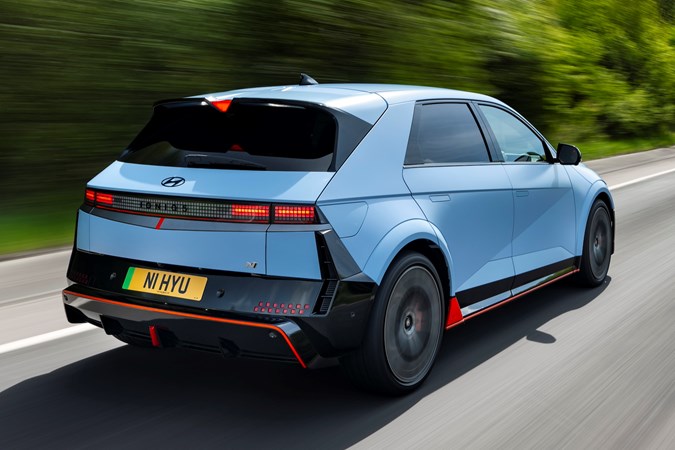
With this tech, Hyundai has fixed the biggest issue we have with driving an EV quickly. In a normal electric car, because you don’t have a screaming engine to give you a frame of reference, your sensation of speed is completely warped.
That means you find yourself approaching corners far too quickly to round them safely until you’ve recalibrated your senses. But because Hyundai’s simulated engine/gearbox combo meters out the Ioniq 5 N’s colossal performance in familiar chunks, it’s far easier to pace yourself.
We appreciate we’ve given the N a glowing review thus far, so we should probably discuss some of its limitations. Namely its weight. Despite Hyundai’s best efforts, this five-seat hot hatchback weighs a staggering 2.2 tonnes which, to drag that figure into focus, is just 100kg shy of a Range Rover.
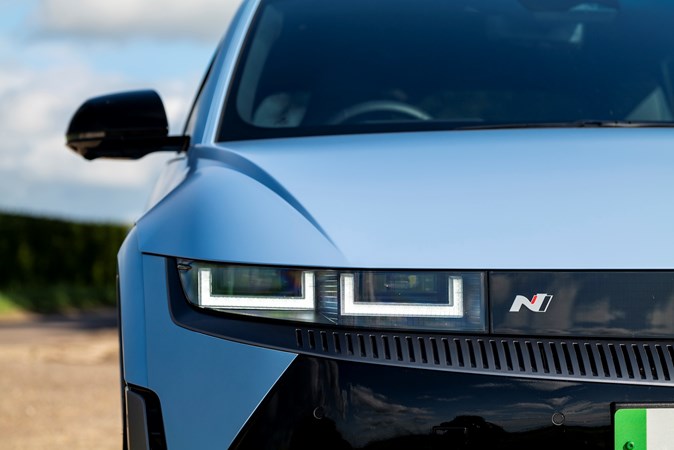
Hyundai claims it’s managed to mask that weight with an uber-quick steering rack, sneaky suspension trickery and clever software. But no matter how hard the winds of marketing bluster may howl, the good ship physics remains immovable.
When you’re driving quickly, the Ioniq 5 N’s tyres will scream in protest long before they would in a traditional super hatch (such as an Audi RS 3 or Mercedes-AMG A 45 S), simply because they’re battling with an extra 600kg of mass. Our advice? If you’re planning on using the N for track work, make sure you set aside a healthy budget for rubber.
The Hyundai’s weight penalty is so huge that we reckon the slower Audi and Merc would squeak away from it in a series of technical corners. However, the N would claw back the lost ground on a straight thanks to its 200hp performance advantage. In any case, though, it’s easily one of the best-handling electric cars you can buy.
Range and charging
The Ioniq 5 N has an 84kWh battery pack, which is bigger than the 77kWh unit fitted to the standard car. It provides a maximum official range of 278 miles, which isn’t bad at all. Just remember, that range will vary depending on how hard you drive – so if you’re making the most of the performance, expect to charge up more regularly. We averaged 200 miles on a fairly enthusiastic UK test route.
Hyundai’s E-GMP architecture also brings class-leading DC charging speeds of up to 350kW. If you can find a charger capable of supplying that much power, you’ll be able to charge the battery from 10 to 80% capacity in just 18 minutes. Using a 7kW wallbox charger it’ll take 11.5 hours to complete a 10–100% charge, while a 10.5kW unit can fully replenish the cells in 7hrs 35 mins.

It’s also worth noting that the Ioniq 5 N supports Plug & Charge. That means you don’t need to faff about with a payment card at the charge point. Once you’ve registered your card to the car, your charging payments are taken automatically.
What models and trims are available?
The Hyundai Ioniq 5 N is only available in one trim for now. However, it comes with plenty of standard equipment, including 21-inch alloy wheels, heated and ventilated front seats, a head-up display, Apple CarPlay and Android Auto, a surround-view monitor and a Bose Premium Audio system.
A one-piece panoramic glass roof is also available as an option and there are eight paint finishes to choose from, including the rather natty matte blue finish shown here. Oddly for a £65,000 car, though, the N’s seat adjustment is entirely manual. This stands out against its similarly priced rivals that have partial or even fully electric seats.
Hyundai is also considering launching a roster of factory extras, following the same strategy as BMW’s M Performance parts catalogue. It’ll include items like alloy wheels, lowering springs, different brakes and lairier body panels. However, the company hasn’t yet decided whether it’ll offer the service in the UK.
Now click through to the next page to read our verdict of the Hyundai Ioniq 5 N.





